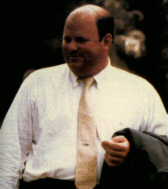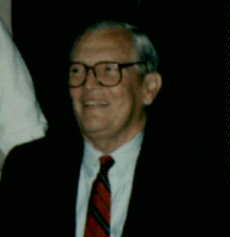

After attending Rollins College and Stetson University in Florida, Pete Dye was employed as a life insurance salesman in Indianapolis. As a fine amateur golfer, he want the Indiana Amateur in 1958 after being runner-up in 1954 and 1955. He also served as chairman of the Green Committee at CC of Indianapolis, where he guided the club through a major replanting of its course. In 1959 dye left the insurance business after becoming one of the youngest members of the "Million Dollar Round Table" in his company. With his wife Alice, he laid out his first course that same year and soon embarked on a career in course design.
Dye had done a series of low-budget course in the Midwest by 1963, when he and Alice toured the great courses of Scotland. When they returned, Pete began to incorporate into his designs several of the features and principles they had observed in Scotland, including small greens, undulating fairways, pot bunkers, railroad tie bulkheads and deep native roughs. The characteristic Pete Dye style that evolved had considerable impact on late-twentieth century course architecture.
Dye created some of the world's top course, including Teeth of the Dog in the Dominican Republic, The Golf Club near Columbus, Ohio, Harbour Town Golf Links on Hilton Head Island, S.C. and the original Tournament Players Club at Ponte Vedra, Florida. The latter ushered in an era of "stadium courses" designed with massive spectator mounds.
Back to Toshi's Golf Home Page

Alice Dye

Alice O'Neal Dye (1927- ) Born: Indianapolis, Indiana
Alice O'Neal met her future husband, Pete Dye, while both were students at Rollins College in Winter Park, Florida. They married in 1950 and moved to her hometown of Indianapolis, where both became insurance salespersons. They both also worked on their golf games. Pete had some competitive success, but never came close to matching his wife's impressive record. Over the years, Alice Dye won seven Indiana Women's Amateur titles (including three prior to their marriage), three Florida State Women's Amateur titles, five Women's Western Senior Championships and two USGA Women's Senior Amateur Championships. She was named to the 1970 Curtis Cup team at age 42, was selected as Florida Senior Woman Golfer of the Year five years in succession, and was voted to the Indiana Hall of Fame.
Alice left the insurance business after the birth of their first son in 1952, but Pete continued until 1959, when he quit to pursue a career in golf design. Pete and Alice formed a company and began designing and building small-town layouts around central Indiana. It was an extremely low budget operation in the beginning; for one project, Alice propagated a stand of bentgrass in their front yard and transported it to the course site in the trunk of their Oldsmobile.
In those early days, Alice handled all the drafting for Pete. "Pete couldn't read a contour map. I had to teach him," she later recalled. "And he never did learn to draw." While their sons were young, Alice handled projects close to home while Pete went out on the road, and for a time mainly handled the paperwork of the business. Once the boys reached their teens, she again took a more active role in the design aspect of their projects.
Alice Dye considered her most valuable contribution to golf architecture to be the expert attention she devoted to the planning and placement of tees and hazards to create proper challenges for female golfers. For years she spoke and wrote extensively on the need for more than a single set of tees for women. The wide variance in women's skills at any course, she contended, dictated forward and back (and sometimes even middle) tees for women, just as had been provided for years for men.
In 1982 Alice Dye became the first woman member of the ASGCA.
Back to Toshi's Golf Home Page

Perry Dye

Perry O'Neal Dye (1952 - ) Born: Indianapolis, Indiana
Perry Dye, Pete and Alice Dye's older son, first accompanied his golf architect parents to course construction sites at age 12. While still a teenager, he absorbed enough knowledge to be heavily involved in the initial routing of the first course at John's Island, Fla. During college he served as project manager for a number of his father's designs, including Harbour Trees near Indianapolis. After graduating from the University of Denver with a Degree in Real Estate Marketing, Perry Dye left the family business to pursue a career in housing development and construction. The recession of the late 1970's caused him to abandon his plans, and he rejoined his father in the course design business. In 1982 Perry Dye formed his own course design company, Dye Designs, Inc., Based in Colorado, the firm concentrated on real estate development courses. Dye continued to occasionally collaborate with his father on certain designs well into the 1980's. Their most notable joint effort was TPC of Plum Creek near Castle Rock, Colorado.
Back to Toshi's Golf Home Page

P.B. Dye

Paul Burke Dye (1955 - ) Born: Indianapolis, Indiana
P. B. Dye attended the University of Tampa (Fla.) for several years, but his career choice was always golf course design. As the younger son of golf architect Pete and Alice Dye, he learned more about the subject at home and working on various family projects than he did at any school. Resembling his father in voice and mannerisms and his mother in physical appearance, P. B. Dye developed a golf game, and a creativity in course design, that rivaled both of them.
Some of his earliest collaborations with his father attracted immediate national attention. Long Cove Club, on Hilton Head Island, S.C., was named one of America's 100 Greatest courses by Golf Digest magazine only two years after it opened. Their creation at The Honors Course, near Chattanooga, Tenn., was named the Best New Private Course of 1984 by the same publication. By the mid-1980's P. B. Dye was handling course designs entirely on his own.
Back to Toshi's Golf Home Page

Roy Dye

Roy Anderson Dye (1929 - 1994 ) Born: Springfield, Ohio
Roy Dye graduated from Yale University with a bachelor's degree in Chemical Engineering. After a career in that profession for almost twenty years, Roy joined his brother Pete Dye in the practice of golf course design in 1969. After working with Pete on several projects, Roy handled several designs on his own, though many of them - including Waterwood National in Texas and Country Club of Colorado - were still credited as Pete Dye designs. Much of his later work was done in the Southwest and in Mexico.
Back to Toshi's Golf Home Page

 Any comment or message?
Any comment or message? Click here for E-mail
Click here for E-mail
Last Updated March 6, 1996 by
Toshi Uzawa
usgosei@ix.netcom.com